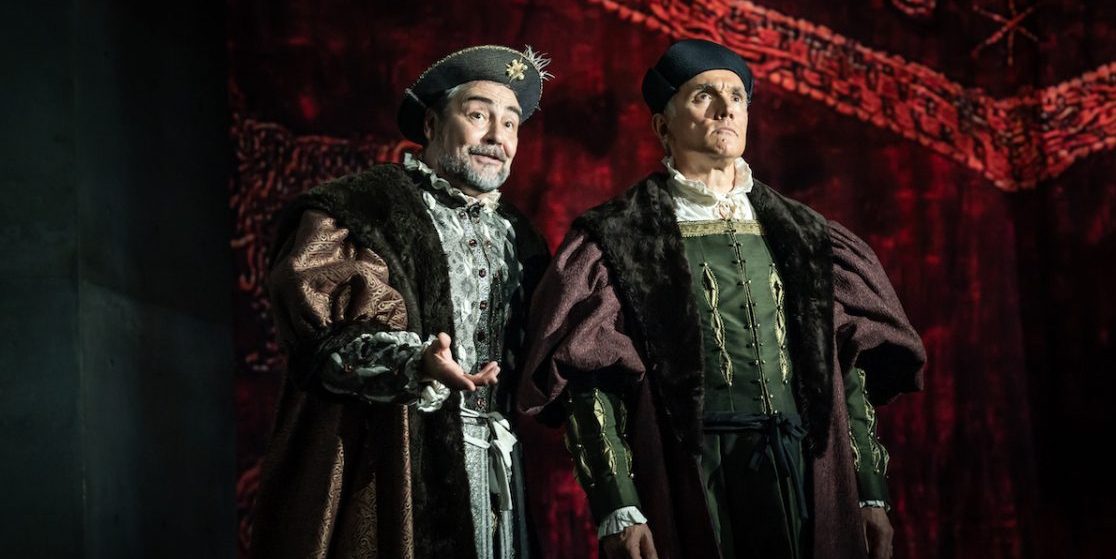The stage version of Hilary Mantel’s first two novels on the rise and fall of Thomas Cromwell was the theatrical event of 2014-15, and now the adaptation of the third novel, ‘The Mirror and the Light’ comes to the West End. Mantel and leading man Ben Miles have carefully selected the key themes from this huge finale which stretches from the fall of Anne Boleyn through to Cromwell’s own demise only four years later. As before, the court rivalries, personality clashes and European context are presented with a light touch avoiding didacticism and decorating the narrative with colour, wit, and humour.
But this is not merely high-quality, stream-lined storytelling. As always with this author, there are shrewd general lessons on politics too. No more so in explaining Cromwell’s ultimate downfall. He makes two key mistakes that many experienced politicians still fall for – he is too clever by half in arranging a new marriage for the king, a nifty piece of diplomacy that forgets the simple fact that he must find a bride the king can love. And secondly, he becomes so busy he neglects to keep up with the facetime that has been the essential vivifying cord between himself and Henry. Once others usurp it, he is quickly undone, especially with someone as emotionally needy as Henry VIII. Essentially, he neglects the basics that won him power.
The acting is of the highest quality across the large ensemble. There are opportunities for all to excel and even the minor characters are sketched in with precisely calibrated care for detail. Quiet, candle-lit soliloquies of Shakespearean eloquence alternate with ceremonial courtliness, earnest and pious devotion, devious conspiracy, humorous joshing, and – unsurprising in a finale – backward glances of regret. At the centre lies the fracturing relationship between Cromwell and Henry, the one over-confident at the peak of his power, the other increasingly testy, in pain and dissatisfied. Ben Miles and Nathaniel Parker ensure that this relationship glitters in all its facets at the centre of the drama, so that when Henry casts Cromwell aside finally it is both shocking and entirely prepared for.
But the beauty of the play is that we see the same events freely from the perspective of all sides – Jo Herbert’s cynical Lady Rochford sees further than Cromwell himself, Olivia Marcus captures the sweetness and compliance of Jane Seymour, Henry’s third queen, and Rosanna Adams the tough, plain-spoken gaucheness of the briefest bride, Anne of Cleves. There is a stand-out performance from Melissa Allan as Henry’s neglected daughter, Mary, who duels with great guts with Cromwell despite her constrained position. While lacking formal power, the women wield it when every chance comes their way.
The brutality of court life is exemplified in the portraits of the Duke of Norfolk (Nicholas Woodeson) and Bishop Gardiner (Matthew Pidgeon) both biding their time to take their revenge in detail on Cromwell. There is some splendidly hypocritical and oily work from Geoffrey Lumb and Leo Wan, as acolytes of Cromwell who turn to betrayal when the wind of favour shifts, and a wonderfully blousy incursion from Tony Turner as the ghost of Cardinal Wolsey.
Just as much credit belongs to the creative team though, who often get overlooked in reviews. The relatively plain concrete set by Christopher Oram turns out to be a wonderfully flexible vehicle whether for intrigue, dance, rebellion, or nightmare. Colour is there in abundance in Oram’s meticulous period costumes and backdrops, and subtle changes of mood are registered in each scene by the exceptional lighting design of Jessica Hung Han Yun. She offers an object lesson in adding warmth or chill to prison cell, church or private study and lends momentum to the rapid flow of scenes essential in such a plot-driven play. Stephen Warbeck’s music fits the bill too, and I wish we had had more of it.
In any adaptation of a novel there will always be scenes you miss, and personally I would have liked to hear more about and from the painter Holbein, whose depiction of the aristocracy of Tudor England still shapes our visual impressions and who is given a large role in the novel. But with such riches on the table, it is churlish to ask for more. This adaptation delivers as it should and completes a masterly transfer from one medium to another, with the televisual finale still to come to complete the set.

